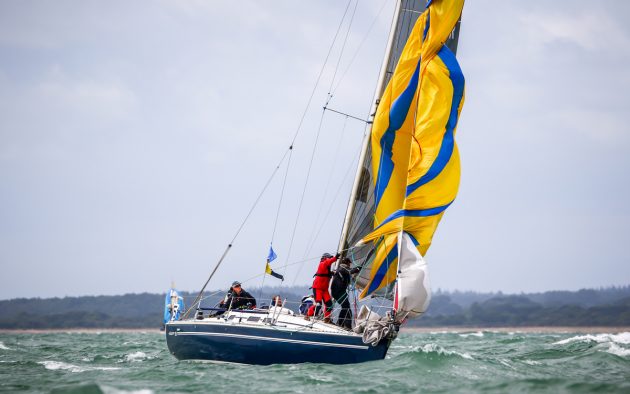From prevention to recovery, pro sailor Pip Hare explains how to handle spinnaker wraps
I can still feel the pain of my first really bad single-handed spinnaker wrap. I was in the middle of the Atlantic Ocean, took my eye off the sail for just one second to dunk a biscuit in my tea and my fate was sealed.
Four hours later I had managed to get the sail down. It had wrapped around the forestay as well as a spare halyard, and the more I unwrapped the bottom the worse the top got. By the time I had finished I was exhausted and my fingertips were bleeding from pulling on the fabric. No one in their right mind would want to go through that pain, so here are my top tips to avoid spinnaker wraps.
Preventing spinnaker wraps
When hoisting straight from the bag, the aim is to separate the clews then get the head to full hoist as quickly as possible. Always sheet the guy or tack on first; if it’s breezy you can wool this front corner. Hoisting behind a jib will keep wind out of the head for longer and avoid it spinning on the halyard swivel. If you are sailing with crew, your bowman can also run the leech of the sail as it goes up.
Hoisting from a snuffer, the head will already be in the air so you only need to stretch out the foot. Get your tack or guy on before hoisting the sock, then steer a deep course to reduce apparent wind. As the sock goes up, sheet on as hard as you can. Be ready to ease the sheet the minute the sail fills.
Article continues below…
Mongrel drop: Pip Hare’s guide to unorthodox kite drops
Emergency drop, small crew For hurried drops of asymmetric spinnakers, particularly with a small crew, I consider the gybe drop…
5 tips: spinnaker drop – how to drop the kite without drama
The leeward drop and mark rounding was looking fine and you were about to nail a few more places, so…
Wraps while hoisting and gybing
With the jib still up, the foredeck crew should grab the spinnaker leech from behind the jib and pull down on it hard, gathering the material in their hands to try and make a straight line down the leech. This will deflate the sail and can often chase the wrap out through the top.
If the wrap is not moving and the halyard is at full hoist, ease the head by a maximum of 3m, this will allow the sail to fly away from the mast giving extra room for the swivel to work. Pull on the leech again, but if the wrap will not come out you may need to drop the spinnaker.
For sails in snuffers, easing the halyard will not help the head spin, your only option is to pull down on the leech. Take extreme care: consider clipping on and be ready to release the sail if it suddenly fills.
Asymmetric spinnaker wraps while gybing can normally be pulled out by sheeting on and heading up after the gybe – it’s all about how quickly you can get leech tension on the new sheet. If that doesn’t work, sometimes the best option is to gybe straight back. If you can see the spinnaker wrapping during the gybe, go back, then try again.
Spinnaker wraps around the forestay
These are the worst kind of wraps, as they can stop the spinnaker from coming down. They normally happen when the sail has been momentarily deflated, often at nighttime, in sloppy seas, when sailing dead downwind or when the helmsman is distracted.
If racing, you should be able to avoid this through good communication: if the trimmer feels the apparent breeze drop or sees the spinnaker start to collapse they can call the helmsman to steer up. On longer passages you can hoist something up the forestay to stop the spinnaker from passing through the gap. A small jib works well on boats with bowsprits or symmetric kites.
If flying a cruising chute from the bow, using a jib may smother the chute, so another method must be found. A spinnaker net is a sail made of mesh that is specifically designed for this purpose and can be made up by a sailmaker.
Alternatively, create a web yourself using a spare halyard and babystay or emergency forestay. Pass the halyard around the forestay, then the inner stay and back to the forestay a few times to create a web that the spinnaker cannot pass through. Bear in mind that this solution would make a quick gybe or jib hoist quite difficult.
If you do get a forestay wrap it can be an enormous job to undo. The important rule is to know when to cut your losses. It is possible to ‘sail out’ these wraps but is also easy to sail more in. Unless you are confident that you can sort the mess out, quit while you are ahead and get the sail down.
Quick tips
- Use luminous tape to make the leeches of your spinnakers visible in the dark. This will help you see the kite collapsing.
- If your spinnaker bags are old and soft, invest in new ones with good Velcro and solid sides to keep the sail well packed in the bag.
- If you’ve not used your snuffer for a while, lay it out on the dock, lift the sock and run the tapes.
- When the spinnaker is flying, always keep spare halyards at the mast, not on the pulpit to prevent the sail from tangling with the lines.
First published in the October 2017 edition of Yachting World.






